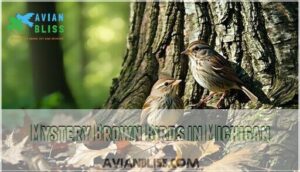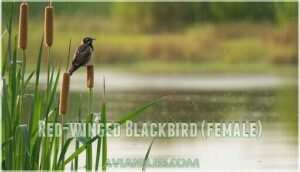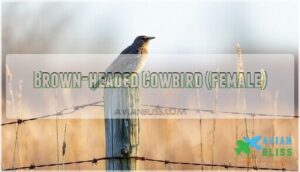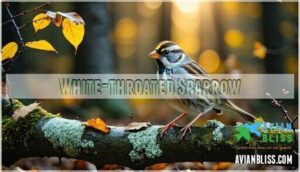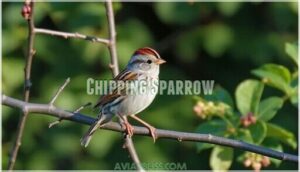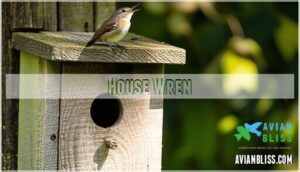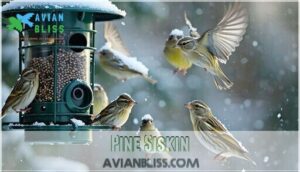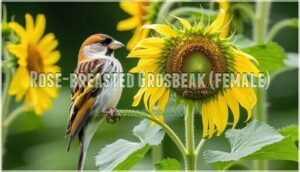This site is supported by our readers. We may earn a commission, at no cost to you, if you purchase through links.
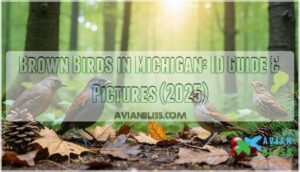
You’ll encounter streaky sparrows, plain-Jane female blackbirds, and earth-toned wrens across the state’s forests, fields, and backyards.
Female Red-winged Blackbirds sport heavy streaking that’ll fool you into thinking "sparrow," while Brown-headed Cowbirds wear subtle chocolate plumage.
House Wrens chirp from suburban gardens, and White-throated Sparrows flash their signature throat patches.
Don’t overlook Pine Siskins with their needle-sharp bills or female Rose-breasted Grosbeaks sporting chunky seed-cracking beaks.
Each species has telltale field marks that separate the wheat from the chaff once you know what to watch for.
Table Of Contents
- Key Takeaways
- Mystery Brown Birds in Michigan
- Common Challenges in Identifying Brown Birds
- Red-winged Blackbird (female)
- Brown-headed Cowbird (female)
- White-throated Sparrow
- Chipping Sparrow
- House Wren
- Pine Siskin
- Rose-breasted Grosbeak (female)
- Carolina Wren
- Frequently Asked Questions (FAQs)
- What are those common brown birds called?
- Why do I have a brown thrasher in my yard?
- What looks like a mockingbird but is brown?
- What is the brown speckled bird in Michigan?
- What time of year do brown birds migrate through Michigan?
- Which brown birds stay in Michigan during winter months?
- How do male and female brown birds differ?
- What do brown birds typically eat in Michigan?
- Where do brown birds build their nests in Michigan?
- Conclusion
Key Takeaways
- You’ll need to look beyond color – Many brown birds share similar plumage, so focus on key field marks like bill shape, size comparison to familiar birds, and distinctive features like throat patches or wing bars.
- Habitat and behavior are your best clues – Female Red-winged Blackbirds prefer marshes, House Wrens stick to suburban gardens, and Pine Siskins hang upside-down at feeders with their needle-sharp bills.
- Seasonal timing matters for identification – White-throated Sparrows migrate through Michigan in spring and fall, while Carolina Wrens and Brown-headed Cowbirds stay year-round, affecting when you’ll spot them.
- Listen for distinctive calls – You can identify species by sound even when visual ID is tough – House Wrens have bubbly songs, White-throated Sparrows whistle "Old Sam Peabody," and Carolina Wrens belt out "teakettle-teakettle.
Mystery Brown Birds in Michigan
Ever spotted a brown bird flitting through Michigan’s woodlands and wondered what species you’re observing? You’re not alone in this birding challenge. Michigan hosts dozens of brown bird species, from common backyard visitors to rare seasonal migrants that puzzle even experienced birders.
These mystery birds often share similar coloration as camouflage, making michigan bird identification tricky. Small brown birds like sparrows can look nearly identical at first glance, while larger brown bird species vary dramatically in size and behavior.
Habitat clues help narrow possibilities – marshland birds differ from woodland species, and regional variations mean northern Michigan’s avian residents sometimes contrast with southern populations. Seasonal changes add complexity as many species molt into duller brown plumage during winter months.
Female birds of typically colorful species often sport subdued brown tones year-round. Understanding these birding challenges transforms frustrating encounters into rewarding identification opportunities, turning every brown bird sighting into an engaging puzzle worth solving.
Common Challenges in Identifying Brown Birds
Spotting brown birds in Michigan poses unique challenges that can leave even experienced birders scratching their heads.
Many species share similar earth-toned plumage, making quick identification tricky without careful observation.
Lighting conditions dramatically affect how you perceive bird colors – that "brown" sparrow might actually show subtle streaks or rusty highlights in better light.
Plumage variation between seasons, ages, and sexes adds another layer of complexity.
Immature birds often lack the distinctive markings of adults, while females typically display more subdued coloring than their male counterparts.
Key identification strategies include:
- Size comparison – Compare your mystery bird to familiar species like robins or house sparrows
- Behavioral clues – Note feeding habits, flight patterns, and preferred perches
- Habitat preferences – Different species favor specific environments from wetlands to suburban yards
Regional differences across Michigan mean some small brown birds appear only in certain areas.
Similar species like various sparrows require attention to subtle field marks such as bill shape, tail length, and eye patterns for accurate michigan bird identification.
Red-winged Blackbird (female)
Michigan’s streaky brown birds can leave you scratching your head, but the female Red-winged Blackbird has telltale signs that’ll set her apart from the crowd.
Her female plumage lacks the male’s flashy red shoulder patches, instead sporting heavy brown streaking across her chest with a lighter stripe above the eye.
You’ll spot this brown birds michigan regular measuring 7-9 inches long with a sturdy, conical bill perfect for cracking seeds.
Her streaky identification features include that distinctive breast pattern and plain facial appearance that separates her from similar species.
Habitat differences matter too – she prefers marshes and wetlands for nesting but ventures into suburban yards seeking food.
Listen for her sharp "tcheck" call among her vocalizations.
Her nesting habits involve building cup-shaped structures in dense vegetation near water, where she’ll incubate 3-5 eggs solo.
This Redwinged Blackbird female proves that bird identification requires looking beyond the obvious male characteristics.
Brown-headed Cowbird (female)
Female Brown-headed Cowbirds can confuse even experienced birders since they lack the distinctive features of their glossy-black male counterparts.
You’ll spot these plain brown birds with their stocky build, thick conical beaks, and subtle belly streaking in grasslands and suburban areas throughout Michigan.
Female Cowbirds Are Hard to Identify
Female Brown-headed Cowbirds frustrate even experienced birders with their plain brown plumage and subtle features.
These plain brown birds master the art of blending in, making identification a true test of birding skills.
You’ll need sharp eyes to distinguish them from Cowbird look-alikes using these identification clues:
- Thick, conical bill shape – stubbier than sparrows
- Streaking patterns – minimal belly streaks unlike heavily marked species
- Stocky build – shorter tail, rounder head than similar brown birds Michigan
- Habitat clues – open areas with grazing animals
Behavior analysis and careful observation of bill shape separate them from other brownheaded cowbird confusion species in your bird identification guide.
They often thrive in open or semi-open habitats.
Brown-headed Cowbird Range Map
Looking at brownheaded cowbird distribution patterns reveals fascinating insights about these backyard birds Michigan residents encounter year-round.
These brown birds showcase remarkable range expansion across North America, with breeding parasitism driving their population dynamics throughout Michigan bird watching hotspots.
Their spread is visible on a cowbird distribution map.
Understanding their habitat influence helps explain conservation concerns surrounding these adaptive species:
- Year-round residents – Present in Michigan during all seasons unlike migratory brown birds
- Expanding northward – Range expansion continues as climate patterns shift across regions
- Agricultural followers – Population dynamics tied closely to livestock and farming operations
- Breeding parasitism specialists – Successfully exploit over 200 host species for reproduction
- Conservation concerns minimal – Stable populations despite environmental changes affecting other species
Common Sightings in Michigan
You’ll encounter brown-headed cowbirds across Michigan’s diverse landscapes throughout the year.
These common brown birds michigan residents frequent farmlands, grasslands, and suburban areas where they practice their unique brood parasitism.
Female cowbirds show strong habitat preference for areas with grazing livestock, capitalizing on disturbed insects.
Their feeding habits include ground foraging and following cattle herds.
A reliable cowbird identification resource can aid in distinguishing them from other similar species.
Watch for their stocky build and plain brown plumage during seasonal abundance peaks in spring and summer.
White-throated Sparrow
You’ll spot the White-throated Sparrow by its distinctive markings – that crisp white throat patch and bright yellow patch between the eye and bill.
These brown birds migrate through Michigan twice yearly, making spring and fall prime viewing seasons.
Listen for their clear, whistled song that sounds like "Old Sam Peabody, Peabody, Peabody" – it’s unmistakable among Michigan’s brown birds.
Their vocalizations help distinguish them from Song Sparrows and other similar species.
Their habitat preferences include forest edges and shrubby areas where they scratch through leaf litter for seeds and insects.
You’ll often see them hopping on the ground with characteristic head-bobbing movements.
Migration patterns bring these birds from Canadian breeding grounds to southeastern US wintering areas, with Michigan serving as a key stopover.
Their conservation status remains stable, though habitat protection remains important.
To attract White-throated Sparrows, offer millet and black oil sunflower seeds at ground-level feeders.
They’re less skittish than many brown birds, making identification easier for beginners.
Chipping Sparrow
You’ll spot this small sparrow by its distinctive rusty red cap and clean black eyeline that runs through its eye.
Chipping Sparrows are frequent backyard visitors in Michigan, especially around bird feeders where their gray underparts and streaked brown backs make them easy to identify among other sparrow species.
Identifying Characteristics
During spring breeding season, you’ll recognize Chipping Sparrows by their distinctive rusty crown contrasting with a clean white eyebrow stripe and sharp black eye-line.
Their small size comparison to other sparrows, plus pointed beak shapes perfect for seed-cracking, make identification easier.
Listen for their characteristic rapid-fire chip calls – these vocalizations distinguish them from similar species.
Bird identification guides emphasize watching for their ground-hopping behavior while foraging, plus habitat clues like suburban yards and forest edges where these brown birds thrive.
Chipping Sparrow Range Map
You’ll find Chipping Sparrows across most of Canada and northern U.S. during breeding season, making Michigan prime territory for spotting these brown birds.
Migration patterns bring them through the entire United States as they join mixed flocks in fields and woodlands.
Habitat influence plays a major role – they nest in trees and shrubs, raising 2-3 broods annually. Climate change affects their range expansion, pushing some populations further north.
Unlike Song Sparrows or House Sparrows that stick around year-round, Chipping Sparrows winter in Mexico and southern states where population density increases dramatically.
Bird range maps show they’re reliable summer residents throughout Michigan’s forests and open areas. They’re known for their distinctive rusty cap, which is a key identification feature.
House Wren
House Wrens are Michigan’s most energetic brown birds, measuring just 4.7 to 5.5 inches long.
You’ll recognize their bubbly, complex songs echoing through open woodlands and suburban gardens.
These tiny powerhouses sport plain brown plumage with faint wing barring and slightly curved bills perfect for snatching insects.
House Wren Habitat includes gardens, parks, and woodland edges where they actively hunt beetles, caterpillars, and spiders.
Their Wren Song ID is unmistakable – loud, territorial melodies that males belt out during breeding season.
For Attracting Wrens, mount nest boxes 6-10 feet high with small entrance holes.
Their Nesting Habits involve building stick foundations lined with feathers in cavities.
The Wren Diet consists primarily of insects, making them excellent pest controllers for your yard.
These agile birds forage from dawn to dusk, constantly flitting through dense vegetation while defending their territory with surprising aggression for such small creatures.
Pine Siskin
Pine Siskins bring unpredictable excitement to Michigan’s brown birds scene through their irruptive migration patterns.
These streaky finches appear suddenly when northern seed crops fail, transforming quiet feeders into bustling hotspots.
You’ll recognize Pine Siskin by their needle-sharp bills and yellow wing flashes during flight.
Their plumage variation ranges from heavily streaked brown to subtle yellow highlights, making siskin identification tricky at first glance.
Listen for their distinctive raspy "zzzt" calls—they’re chattier than most finches.
Winter foraging behavior sets them apart from resident brown birds.
They’ll hang upside-down on thistle feeders, displaying acrobatic skills that’d make gymnasts jealous.
These nomads prefer nyjer seeds but won’t turn down sunflower hearts.
Their conservation status remains stable despite population swings.
During irruption years, hundreds might descend on Michigan feeders, then vanish completely the next season.
Bird feeders become their lifeline during harsh winters, making your backyard a potential siskin sanctuary when food runs scarce up north.
You might also attract other species, such as the brightly colored goldfinch.
Rose-breasted Grosbeak (female)
Female Rose-breasted Grosbeaks are the sneaky brown birds that’ll fool you at first glance, but their chunky seed-cracking bills and bold white eyebrow stripes give them away.
You’ll spot these hefty visitors at your sunflower seed feeders, especially during spring and fall migration when they’re refueling for their long journeys.
Common Visitors to Feeders
Female Rose-breasted Grosbeaks frequent Michigan feeders, especially during migration periods. These brown birds appreciate varied seed preferences, thriving on sunflower seeds and safflower options.
Many enjoy chewy sunflower options for their unique taste and nutritional value.
Strategic feeder placement attracts these visitors:
- Position feeders near shrubs for quick escape routes
- Maintain consistent winter feeding schedules for reliability
- Install squirrel-proof mechanisms to prevent seed theft
Regular cleaning feeders guarantees healthy bird populations while maximizing your chances of spotting brown birds in Michigan at backyard stations, which is crucial for healthy bird populations and spotting brown birds.
Rose-breasted Grosbeak Range Map
Throughout Michigan’s changing seasons, Rose-breasted Grosbeaks display fascinating Migration Patterns that reveal their adaptability to Climate Change impacts.
These Brown birds Michigan enthusiasts treasure arrive from Central America each spring, establishing Breeding Territory in deciduous forests where Population Density peaks during May through August.
They’re listed as a species of low conservation concern, with stable population numbers.
- Habitat Influence: Prefer mature oak-maple forests with dense understory near water sources
- Spring arrival: Males return first in early May, followed by females for nesting
- Population trends: Climate Change has shifted their range northward by roughly 65 miles since 1970
- Winter departure: Most leave Michigan by late September, heading to tropical wintering grounds
Patient Rosebreasted Grosbeak watchers find success in wooded areas where these striking Michigan bird species forage for insects and seeds, making bird identification easier during their active breeding season.
Carolina Wren
You’ll spot Carolina Wrens year-round in Michigan, where these energetic brown birds belt out their distinctive "teakettle-teakettle" songs from dense cover.
These non-migratory residents have rich brown backs, lighter undersides, and prominent white eyebrows that make them easier to identify than many other brown species, with distinctive songs and prominent white eyebrows.
Carolina Wren Range Map
Carolina Wrens have expanded their range northward into southern Michigan due to Climate Change and milder winters. These brown birds Michigan residents now spot year-round were once confined to southeastern states.
Population Expansion continues as these adaptable birds discover bird habitats Michigan offers plenty of cover. Unlike House Wren cousins, Carolina Wrens don’t migrate south entirely.
Seasonal Variations affect their visibility – they’re most active during breeding season but maintain territories through winter. Conservation Efforts focus on preserving dense understory vegetation they prefer.
Here’s their current range distribution:
| Region | Presence | Habitat Influence |
|---|---|---|
| Southern Michigan | Year-round | Dense shrubs, suburbs |
| Northern Michigan | Rare/absent | Limited suitable cover |
| Peak Range | Southeast US | Ideal breeding conditions |
| Winter Behavior | Local movement | Seek protected areas |
The Carolina Wrens are now a common sight in Michigan, with their range expansion being a notable example of how milder winters are impacting local wildlife. This shift in population is also influenced by the availability of dense understory vegetation.
Watch a Carolina Wren Eating in My Yard!
Backyard bird-watching offers countless rewards when you spot a Carolina Wren’s feeding frenzy. You’ll witness this energetic brown bird hopping through dense shrubs, using its curved bill to probe bark crevices for beetles and spiders.
Wren Diet includes insects year-round, plus seeds during winter months. Watch for distinctive Wren Behavior – that signature tail-cocking when excited.
These small dynamos don’t migrate, so your Backyard Habitat becomes their permanent restaurant. They’ll visit bird feeders for suet and seeds, though they prefer foraging naturally.
Listen for loud Wren Sounds that seem impossible from such tiny bodies. Their melodious calls echo through suburban areas where House Wren cousins also thrive.
During breeding season, observe their Nesting Habits in dense vegetation or cavities. Among brown birds michigan residents encounter, Carolina Wrens stand out with their bold white eyebrow stripe and chestnut plumage, making backyard birds identification more rewarding.
Frequently Asked Questions (FAQs)
What are those common brown birds called?
You’ll spot House Sparrows, Song Sparrows, Brown-headed Cowbirds, House Finches, and Northern Flickers most often. These feathered neighbors hang around backyards, parks, and woodlands year-round, making identification easier for you.
Why do I have a brown thrasher in my yard?
Brown thrashers appear in 8% of summer checklists in Michigan. You’ve got one because your yard likely offers dense shrubs, ground-level foraging spots, and insects they love hunting for.
What looks like a mockingbird but is brown?
You’re likely seeing a Brown Thrasher.
These rusty-brown birds share the mockingbird’s long tail, curved bill, and ground-foraging habits.
But they’re rich brown instead of gray with distinctive white wing bars.
What is the brown speckled bird in Michigan?
You’re probably seeing a Song Sparrow—they’ve got distinctive brown streaks on their chest that form a central spot, plus gray eyebrows and cheeks that make them easy to identify.
What time of year do brown birds migrate through Michigan?
Migratory movements manifest magnificently during spring (April-May) and fall (September-October) when you’ll witness White-crowned Sparrows, Pine Siskins, and various thrushes passing through Michigan’s diverse habitats.
Which brown birds stay in Michigan during winter months?
You’ll find several hardy species that stick around all winter.
Northern Cardinals, Mourning Doves, and House Sparrows tough it out year-round, while Brown Creepers actually become more common during winter months.
How do male and female brown birds differ?
Males and females show distinct differences you’ll easily spot.
Males typically display brighter colors—like Northern Cardinals’ brilliant red versus females’ warm brown with red accents—while females often have muted, streaked plumage for camouflage during nesting.
What do brown birds typically eat in Michigan?
You’ll discover brown birds in Michigan feast on diverse diets: House Finches crack seeds, Northern Flickers hunt ants and beetles, while sparrows munch grains and insects for balanced nutrition.
Where do brown birds build their nests in Michigan?
Ever wonder where your backyard brown birds disappear to during nesting season?
You’ll spot their nests in shrubs, tree cavities, ground vegetation, and even building crevices, depending on each species’ preferences.
Conclusion
Apparently, mastering brown birds in Michigan requires superhuman patience—or just this guide.
You’ve now got the tools to distinguish streaky sparrows from plain-Jane blackbirds without pulling your hair out.
Remember those key field marks: throat patches on White-throated Sparrows, needle bills on Pine Siskins, and chunky beaks on female Rose-breasted Grosbeaks.
With practice, identifying brown birds in Michigan becomes second nature, transforming frustrating "little brown jobs" into confident species identifications during your next birding adventure.

